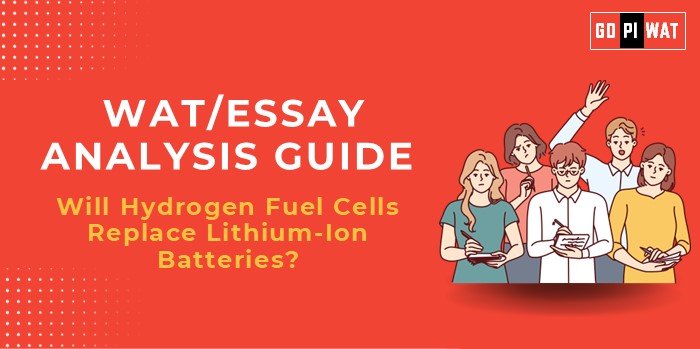📋 WAT/Essay Analysis Guide: Will Hydrogen Fuel Cells Replace Lithium-Ion Batteries?
🌍 Understanding the Topic’s Importance
The choice between hydrogen fuel cells and lithium-ion batteries is pivotal in shaping sustainable energy policies, green infrastructure, and the global shift to renewable energy, all key areas for B-school research and innovation.
⏳ Effective Planning and Writing
- 🧠 Time Allocation:
- Planning: 5 minutes
- Writing: 20 minutes
- Review: 5 minutes
- 📋 Preparation Tips: Gather stats on EV growth, hydrogen projects, and recycling challenges.
💡 Introduction Techniques
- 🌍 Contrast:
“While lithium-ion batteries power 90% of EVs globally, hydrogen fuel cells promise a greener future for heavy-duty applications.” - 🔋 Solution-Oriented:
“The race to decarbonize transport hinges on adopting cost-effective, scalable, and sustainable technologies like hydrogen fuel cells.”
📚 Structuring the Essay Body
- 🏆 Achievements:
- Lithium-ion’s impact on EV adoption and renewable storage.
- Hydrogen fuel cells in long-haul trucking and maritime sectors.
- ⚠️ Challenges:
- Mining impacts, battery recycling, hydrogen costs, and infrastructure gaps.
- 🚀 Future Outlook:
- Innovations like solid-state batteries and green hydrogen production.
🎯 Concluding Effectively
- ⚖️ Balanced Conclusion:
“The synergy between lithium-ion and hydrogen fuel cells, leveraging each for specific applications, could achieve a sustainable energy future.” - 🌏 Future-Focused:
“With complementary roles, lithium-ion and hydrogen technologies can drive a carbon-neutral world.”
✍️ Sample Short Essays (100 Words Each)
- ⚖️ Balanced Perspective:
“While lithium-ion dominates EVs, hydrogen fuel cells excel in scalability for freight and aviation. A hybrid future leveraging both technologies is likely.” - 💡 Solution-Oriented:
“Addressing recycling for batteries and cost for hydrogen will determine the winner of the green energy race.” - 🌏 Global Comparison:
“Japan’s hydrogen leadership and Norway’s EV success demonstrate the coexistence of both technologies for a sustainable future.”


